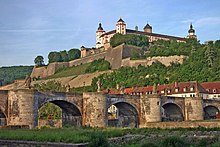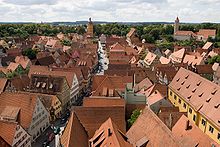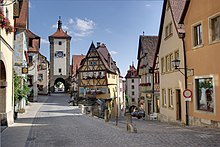| Romantic road | |
 | |
Location  | |
| Itinerary type | Automotive |
|---|---|
| State | |
| Start | Füssen |
| end | Würzburg |
| Tourism site | |
Romantic road (in German: Romantische Straße) is an itinerary that takes place through the Germany.
Introduction


It is one of the most famous and popular German tourist routes. The road crosses various places of historical or landscape interest: it starts from the Main, crosses the Franconia western up to Swabia, pass in Upper Bavaria and arrives in the German Alps. The route is 366 km long and has as its end Würzburg is Füssen.
How to get
More information on Romantic Road from the Main to the Alps.
By plane
Munich International Airport. Second in importance among the German ones, it has two terminals.
By car
- A22 Brenner motorway to the border with Austria
- A13 motorway (Austria) to Innsbruck
- A12 motorway (Austria)
- State road from Imst, Reutte until Füssen
On the train
Most destinations along the Romantic Road can also be reached by train.
By bus
Many places along the Romantic Road have long distance bus service at least daily. In addition to buses which mostly travel the same route, there are buses from as far away places as Berlin for example and from Rothenburg ob der Tauber.
How to get around
L'Europabus operates along the Romantic Road between April and October. € 58.50 is the adult rate from Würzburg to Füssen.
Stages
Bavarian Swabia (Schwaben)
- 1 Füssen - The city was a Roman settlement on the Via Claudia Augusta, a road that connected the colonies of the south to the north of Italy and those of the north to the first regional capital of the Roman province called Castra Augusta, today Augusta. It is the highest city in Bavaria and the last stop on the Romantic Road. The High Castle (Hohes Schloss), the first summer residence of the prince-bishops of Augsburg and one of the oldest and best preserved late Gothic complexes in Swabia, is the stronghold of Füssen. Today the castle houses part of the Bavarian painting collection, which focuses on masterpieces from the late Gothic-Renaissance period. Below the Hohes Schloss is the baroque complex of the former Benedictine monastery of San Magno di Füssen (Sankt Mang).

- 2 Schwangau - The city of Schwangau is located at a height of 800 m and is located on the southwestern border of the German state of Bavaria. The surrounding area is characterized by a transition between the alpine hills of Bavaria and Swabia to the south (on the Austrian border) and the more gently hilly landscape to the north.
- 3 Neuschwanstein Castle - It was built at the end of the 19th century in southwestern Bavaria, opposite the Hohenschwangau Castle. The German name Neuschwanstein it can be translated into Italian as "New Swan stone". Commissioned by King Ludwig II of Bavaria as a personal retreat and homage to the genius of the musician Richard Wagner he particularly loved, Ludovico paid for the construction of the palace with his own funds without accessing the state treasury. The king loved to remain isolated from the world and this place had become a personal refuge for him, but after his death in 1886 it was immediately opened to the public, eager to visit what was praised as an imaginative project. It can be counted among the most visited castles and fortresses in Europe: about 1.4 million visitors per year, of which 6000 per day in summer alone. It has been open to the public since 1886 and has been visited by 60 million people since then. In recent years it has been proposed for the Seven Wonders of the Modern World and is the subject of numerous puzzles and posters. He inspired Walt Disney's fairytale castles, which took him as a model for some of his most famous animated films, including Snow White and the Seven Dwarfs, Cinderella, Sleeping Beauty and Rapunzel. It inspired Pandora's castle from the Knights of the Zodiac anime series. Countless films have been set in the castle, for example it was the "palace of Vulgaria" in the film Chitty Chitty Bang Bang.
- 4 Hohenschwangau - Town, located near the Alpsee lake, consists mainly of hotels and depends exclusively on tourism, which has about 2 million tourists a year. Hohenschwangau Castle is very close to the village and can be reached on foot in about 15 minutes or by horse-drawn carriages, which also allow you to reach Neuschwanstein Castle, a little further from the village (30 minutes on foot), to which you can also arrive by car. Near Neuschwanstein is the Pollat gorge, topped by a 90 meter high bridge (Marienbrücke) from which you can enjoy a splendid view of the castle and the Bavarian mountains. From the village, it is also possible to go up, through a cable car (830-1730 meters above sea level), on Mount Tegelberg, which overlooks the whole area of the castles.
- 5 Hohenschwangau Castle - Originally Hohenshwangau Castle was a medieval fortress, already mentioned in the 12th century; over the centuries, it changed owners several times until it was abandoned and ruined. In 1829 Maximilian II, Ludwig II's father rediscovered it, bought the property and had it restored; thanks to him, the manor was transformed into a palace becoming a place now very popular with tourists. Nearby, as the crow flies opposite, is the dynastically descending Neuschwanstein Castle.
- 6 Halblech —
Upper Bavaria (Oberbayern)
- 7 Steingaden —
- 8 Peiting —
- 9 Schongau —
- 10 Hohenfurch —
- 11 Landsberg am Lech —
Point 12 - Deviation from the main itinerary
- 12 Munich - It is the capital of Bavaria and the most important city in southern Germany, thanks to its royal residences, its immense parks, its museums, its Baroque and Rococo churches, its Bavarian folklore still very much alive, its proximity to the Pre-Alps and the Alps and naturally thanks to beer and its most famous event, the Oktoberfest. The patron saint of the city is San Benno of Meißen.
From point 13 to point 19
- 13 Friedberg —

- 14 Augusta - Founded in 15 BC during the reign of Emperor Augustus, after Trier it is the oldest German city. Augsburg is the third most populous city in Bavaria after Monk is Nuremberg. The city is the bishopric of the Catholic diocese of Augusta. Until the end of the Renaissance Augusta was an important center for the economy and trade. It was the site of important political events including the Peace of Augusta of 1555 which defined the religious status of Germany after the Protestant Reformation. During the Second World War Augusta suffered significant damage. With over 300,000 fire bombs, the historic center was almost completely destroyed.
- 15 Donauwörth - The city was founded with the name of Ried in 500, consisting of a simple village. The first bridge over the Danube dates back to the year 955, the town hall was erected in the year 1236 and the village obtained the status of a city in 1301. Formerly a free city of the Holy Roman Empire, it was the site of one of the incidents that led to the War of the thirty years (1618-1648). On 2 July 1704 it was the scene of the Battle of Schellenberg (also known as the "Battle of Donauwörth"), during the War of the Spanish Succession (1701-1714). The town is located on the banks of the Danube, at the point where the river Wörnitz flows into it.
- 16 Harburg —
- 17 Nördlingen - It rises inside the large crater formed 15 million years ago following the fall of a large meteorite. It was mentioned in a document as a "royal court" in 898. In 1998, Nördlingen celebrated its one hundredth anniversary. The town retains a medieval layout with well-preserved walls and fortifications. The historic center is enclosed by walls that can be covered on foot along the guard path.
- 18 Möttingen —
- 19 Wallerstein —
Middle Franconia (Mittelfranken)
- 20 Dinkelsbühl - Its historic center is made up of beautiful residences and 16 towers. St. George's Cathedral is one of the most beautiful late Gothic cathedrals in all of Germany. At night the custom of the night watchman who makes his rounds in the illuminated historic center is still respected. The town received the same municipal rights from Emperor Henry V in 1305 Ulm. In 1351 it was recognized as a free city of the empire and the wisdom of its rule is documented in the collection of laws known as "Dinkelsbühl's Law".
- 21 Feuchtwangen —
Point 22 - Deviation from the main itinerary

- 22 Nuremberg - It is the economic and cultural center of Franconia. In size it is the second largest city in Bavaria, with over half a million inhabitants. The city is located on the banks of the Pegnitz river which rises about 80 km north-east of the city and crosses it from east to west for about 14 km and then joins, a few km north of the city of Fürth with the Rednitz river to form the Regnitz. The city center is bordered to the north by the hill on which the castle with its walls is located. The historic center, which suffered severe damage during the bombing of the Second World War, has been partially rebuilt. It still has interesting buildings from a historical and artistic point of view: the Imperial Castle, the Church of San Sebaldo and the Frauenkirche.
From point 23 to point 30
- 23 Schillingsfürst —
- 24 Rothenburg ob der Tauber - The historic center that stands on the top of the hill is enclosed by walls that can be walked on along the guard path. They are equipped with towers, bastions and gates like the Roeder Tor, which, preceded by bastions and two low towers, is surmounted by a high tower, then the Wurzburger Tor and the Klingen Tor dominated by a tower with juts. In front of this door is the Wolfgangzkapelle, church of 1475. Another door is the Burgtor, fortified and also dominated by a tower that is higher than all the others, a mighty watchtower also overlooks the gate called Kobolzeller Tor from the 13th century. Bella is the central square, called as in almost all German cities Marktplatz (market square), surrounded by notable buildings including the Town Hall (Rathaus) consisting of two parts: a classical one with a rusticated portico, a roof terrace and a scalar tower from 1572-78 and the other Gothic from the 13th century surmounted by a slender tower from the 16th century. Inside the Town Hall building you can visit the Gothic Kaisersaal, imperial hall, linked to the memory of the Meistertrunk that is the "masterful drink" of wine offered in 1631 during the Thirty Years' War by the citizens to the Belgian Marshal Johann Tserclaes, Count of Tilly, who profited from it and saved the city from destruction.
- 25 Creglingen —
- 26 Röttingen —
- 27 Weikersheim —
- 28 Bad Mergentheim —
- 29 Lauda-Königshofen —
- 30 Tauberbischofsheim —

- 31 Würzburg - Located on the River Main, equidistant from Frankfurt and Nuremberg (both about 120 km), the city is an ancient bishopric and university (founded in 1402, the first Bavarian university) and a popular tourist destination as the origin of the Romantic Road and thanks to the famous Residence, recognized by UNESCO as a World Heritage Site in 1981. It is also known as the seat of the new Vita Universale religious movement.

- 32 Marienberg Fortress - For its elevated location, a fortress of refuge and a pagan place of worship had already been built on the hill in the Celtic age. In the place of the latter, the circular "Marienkirche" was erected in 706, the oldest church in Würzburg. The fortress underwent progressive mutations over the years. The oldest parts that have been preserved until now are over a thousand years old. From 1253 to 1719 the fortress also became the residence of the bishops of Würzburg. From 1573 it took on the appearance of a Renaissance castle. During the Thirty Years War the fortress was conquered by the Swedes (1631), transformed in the Baroque style and equipped with a garden. Under the prince-bishop Johann Philipp von Schönborn (1642-1673) the building was reinforced with numerous star-shaped bastions. In the courtyard, next to the fortress tower, is the Renaissance Brunnenhaus, an octagonal building to protect the 105-meter deep well. In the pitched battle of the Main (1866) the Prussian bombardments unleashed a powerful fire at the Marienberg, but the artillery of the fortress was able to respond and the fortress remained unconquered until the truce. The Marienberg Fortress now houses the "Mainfränkisches Museum" (Franconian Museum) and the "Fortress Museum".
.jpg/220px-Fürstbischhöfliche_Residenz_Würzburg_(10513955236).jpg)
- 33 Würzburg Residence - The Würzburg Residence, with the court gardens and the residence square, has been declared by UNESCO World Heritage. The palace was designed by one of the most important architects of the Baroque, Balthasar Neumann, commissioned by the Prince Bishop Johann Philipp Franz von Schönborn and his brother Friedrich Carl in 1720 and was completed in 1744. Inside there are splendid frescoes made by the Venetian painter Giovanni Battista Tiepolo. Among the most valuable glimpses of the interior, the monumental staircase, the chapel and the hall must be remembered. The Würzburg Residence suffered severe damage during the bombing of the Second World War, after which massive restoration work began, which lasted until 1978 when the castle was reopened to the public. The building has a roughly rectangular plan, 167 meters long and 97 meters wide, with a large space reserved for the garden in the direction of the city. The complex has the typical "U" structure and contains four different courtyards in the lateral wings and two smaller ones in the central part, as well as a series of buildings outside the palace itself that were used to house the offices of the diocese. The entire structure consists of 400 rooms. When the works on the construction of the residence were completed, those for the gardens were begun.
Safety
Around
Other projects
 Wikipedia contains an entry concerning Romantic road
Wikipedia contains an entry concerning Romantic road Commons contains images or other files on Romantic road
Commons contains images or other files on Romantic road



